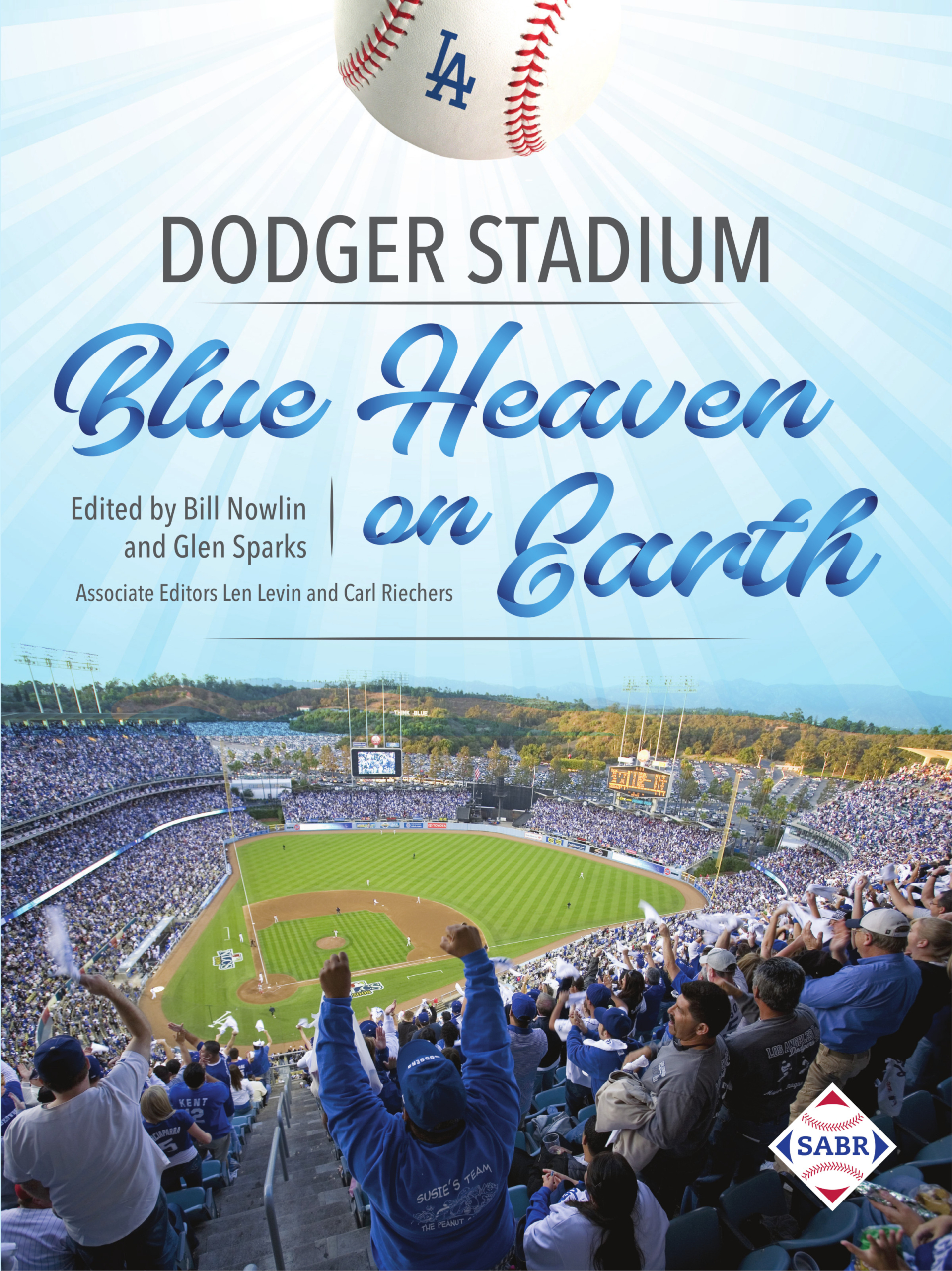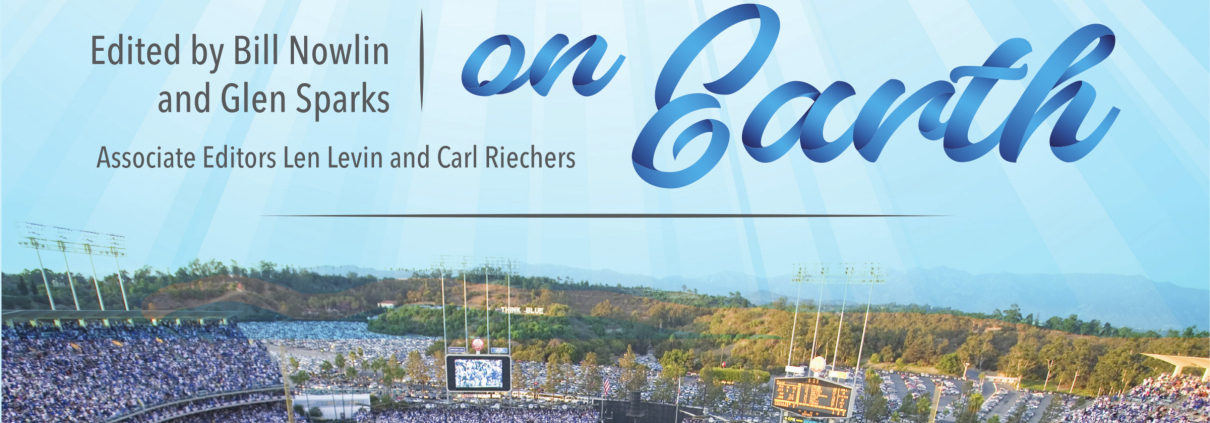Introduction: Dodger Stadium: Blue Heaven on Earth
This article was written by Glen Sparks
This article was published in Dodger Stadium: Blue Heaven on Earth (2024)
“Blue heaven on earth” – Tommy Lasorda on Dodger Stadium
 Dodger Stadium is the third oldest ballpark in major-league baseball. Only Fenway Park and Wrigley Field have been hosting games longer than the House That Walter O’Malley Built. The iconic venue that sits atop a hill just north of downtown Los Angeles, with views of both the city and mountains, turns 62 years old in 2024.
Dodger Stadium is the third oldest ballpark in major-league baseball. Only Fenway Park and Wrigley Field have been hosting games longer than the House That Walter O’Malley Built. The iconic venue that sits atop a hill just north of downtown Los Angeles, with views of both the city and mountains, turns 62 years old in 2024.
This SABR Digital Library book, Dodger Stadium: Blue Heaven on Earth, chronicles the rich history of Dodger Stadium and the great games played there. You’ll read about Sandy Koufax’s perfect game, Don Drysdale’s scoreless-innings streak, Dusty Baker’s historic 30th home run in 1977, and much more. Of course, the book includes an account of Kirk Gibson’s miraculous home run in Game One of the 1988 World Series and the 4+1 game in 2006. Some stories include quotes from the team’s beloved former broadcaster Vin Scully.
The Dodgers, as most baseball fans know, have their roots in Brooklyn, New York, where they were founded in 1883. They won some pennants in the early days before suffering through a series of losing seasons and gaining the nickname of the Daffy Dodgers. They are most famous, of course, for being the “Boys of Summer,” with such great players as Jackie Robinson, Duke Snider, Pee Wee Reese, Gil Hodges, and Roy Campanella. The Brooklyn Dodgers won their lone World Series in 1955. Two years later they were gone, having moved from Flatbush to Southern California.
During those first years on the West Coast, the Dodgers played at the Los Angeles Memorial Coliseum, a gigantic venue more suited for football than baseball. The New York Daily News lamented that the Coliseum made “a mockery of big-league baseball.” The Dodgers won a World Series in 1959 with home crowds of more than 92,000 for all three games. Fans kept transistor radios pressed against their ears so they could hear Scully describe the faraway action. Owner Walter O’Malley already had a new spot picked out for his team. He supposedly spotted the Chavez Ravine site while taking a helicopter ride over the LA basin.1
The Dodger Stadium origin story is a colorful one and not without controversy. This book covers not only the construction of the ballpark – and all the political events that preceded it – but also the Battle of Chavez Ravine, a protracted conflict that concluded with the destruction of a close-knit, mostly Mexican American, neighborhood.
Ground was broken for Dodger Stadium on September 19, 1959. Workers moved more than 8 million cubic yards of dirt and rocks from the rugged hillside. Nineteen giant earth movers flattened the hills and filled in the many gullies. The construction bill ran to about $23 million.2
Dodger Stadium hosted its first baseball game on April 10, 1962. The home team lost to the Cincinnati Reds, 6-3. Dodgers coach and former manager Leo Durocher offered a glowing review of the new ballpark. “I had to see it to believe it,” he told the Long Beach Press-Telegram. “It’s not only beautiful, but it’s also practical. All the fielders have room to move around. And there’s not a bad seat in the house.” Reds outfielder Wally Post said, “Nobody will get cheap homers here. The park is really beautiful, though, and sure shames some of those other dinky things we play in.”3
The tough one-two pitching combination of Koufax and Drysdale led the Dodgers to three pennants and two World Series titles in the 1960s. Opposing hitters battled tough pitches thrown in hazy sunshine. The 1970s Dodgers won three pennants and in 1978 were the first team to draw more than 3 million fans. Fernando Valenzuela burst onto the scene in 1981, bringing “Fernandomania” and the team’s first World Series championship since 1965. The Dodgers won another title in 1988.
Fans still flock to Dodger Stadium, the home of maybe baseball’s most famous concession, the Dodger Dog, and the many palm trees that sway in the soft breezes. Several improvements have been made over the years. Those include LED video displays and a better sound system, plus a children’s playground, and more concession options – including Tommy Lasorda’s Trattoria.
After the Dodgers won the 2020 World Series, the Centerfield Plaza opened. Fans can enjoy new sports bars and seating areas, displays of team memorabilia, and statues of Koufax and Robinson.4 A family area was also added. Janet Marie Smith, who worked on the construction of Oriole Park at Camden Yards and the renovation of Fenway Park among other projects, said, “We sent a clear message that this is a family-friendly place, and the kind of atmosphere here is one for all generations to enjoy.” She told Bill Shaikin of the Los Angeles Times, “Too much is too much. You still want an intimacy. We’re still here to watch the game and celebrate the Dodgers. We weren’t looking to create a theme park. We were looking to create the kind of amenities that other ballparks have, but in a way that respected the original architecture of Dodger Stadium.”5
Former Los Angeles Angels superstar Shohei Ohtani signed a $700 million contract with the Dodgers before the 2024 season. Japanese pitcher Yoshinobu Yamamoto also signed a big deal to play for the Dodgers, who finished in first place with a 100-62 record in 2023 and boasted such great players as Mookie Betts, Freddie Freeman, and Clayton Kershaw. More than 3.8 million fans filed into the ballpark built atop a hill. The future seems bright for both the Dodgers and Dodger Stadium.
This book is the collaborative effort of 49 members from the Society for American Baseball Research.
GLEN SPARKS has many fond memories of going to Dodger Stadium. While he now lives far away from California, he still follows the team that plays its home games in a ballpark that sits on a hill. Sparks is a graduate of the Santa Monica Little League program and has a bachelor’s degree in journalism from the University of Missouri. He worked at a newspaper for several years and wrote a full-length biography of Hall of Fame shortstop Pee Wee Reese, published in 2022 by McFarland. He has co-edited several books for SABR (including this one) and has written many articles. He is married to his wife, Pam.
- Read more: Find all essays from Dodger Stadium: Blue Heaven on Earth in the SABR Research Collection online
- Games Project: Find articles on Dodger Stadium memorable games at the SABR Games Project
- E-book: Click here to download the e-book version of Dodger Stadium: Blue Heaven on Earth for FREE from the SABR Store. Available in PDF, MOBI, EPUB/Kindle formats.
- Paperback: Get a 50% discount on the Dodger Stadium: Blue Heaven on Earth paperback edition from the SABR Store ($17.95 includes shipping/tax; delivery via Amazon Kindle Direct can take up to 4-6 weeks.)
NOTES
1 Andy McCue, Mover and Shaker: Walter O’Malley, the Dodgers and Baseball’s Westward Expansion (Lincoln: University of Nebraska Press, 2014), 221.
2 Nathan Masters, “They Moved Mountains to Build Dodger Stadium,” PBS SoCal, October 11, 2013, https://www.pbssocal.org/shows/lost-la/they-moved-mountains-to-build-dodger-stadium.
3 Hank Hollingsworth, “It’s Unanimous – Dodger Plant Best,” Long Beach Press-Telegram, April 11, 1962: 53.
4 Eric Stephen, “Dodger Stadium Upgrades Ready to Be Seen,” truebluela.com, April 8, 2021, https://www.truebluela.com/2021/4/8/22373029/dodger-stadium-upgrades-center-field-plaza-shake-shack.
5 Bill Shaikin, “Commentary: Dodger Stadium Renovations Are Latest Masterpiece Designed by Janet Marie Smith,” Los Angeles Times, April 7, 2021, https://www.latimes.com/sports/dodgers/story/2021-04-07/on-baseball-dodger-stadium-renovations-janet-marie-smith.


